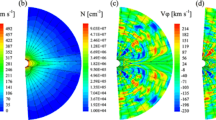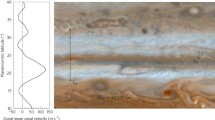Abstract
Alfvénic turbulence is usually invoked and used in many solar wind models (Isenberg and Hollweg, 1982, J. Geophys. Res. 87:5023; Tu et al. 1984, J. Geophys. Res. 89:9695; Hu et al. 2000, J. Geophys. Res. 105:5093; Li 2003, Astron. Astrphys. 406:345; Isenberg 2004, J. Geophys. Res. 109:3101) as a process responsible for the transfer of energy, released at large scale in the photosphere, towards small scale in the corona, where it is dissipated. Usually an initial spectrum is prescribed since the closest constraint to the spectrum is given by Helios measurements at 0.3 AU. With this work we intend to study the efficiency of the reflection as a driver for the nonlinear interactions of Alfvén waves, the development of a turbulent spectrum and its evolution in the highly stratified solar atmosphere inside coronal holes. Our main finding is that the perpendicular spectral slope changes substantially at the transition region because of the steep density gradient. As a result a strong turbulent heating occurs, just above the transition region, as requested by current solar wind models.
Similar content being viewed by others
Avoid common mistakes on your manuscript.
1 Introduction
Alfvén waves are a dominant component of the fluctuations observed in the fast streams of the solar wind, at least at the solar minimum. Measurements of non-thermal line width in polar regions show the presence of Alfvénic fluctuations close to the solar surface, suggesting their solar origin. During their propagation in the stratified atmosphere, waves are partially reflected by the density gradients in the chromosphere, at the transition region and in the low corona. Nonlinear interactions, occurring among counter-propagating waves, are hence triggered and driven by reflection, which in turn lead to the formation of a turbulent spectrum in planes perpendicular to that of the wave propagation (see for example Cranmer and van Ballegooijen 2005; Dmitruk et al. 2000, 2001; Verdini and Velli 2007). We study the evolution of the reflection driven spectrum, formed, according to the above mechanism, from Alfvén waves injected at the base of the chromosphere and propagating upward, beyond the Alfvénic critical point of the specified solar wind. The chromosphere is modeled as an isothermal layer of 2,400 km, while the transition region is modeled as a discontinuity through which the energy flux carried by the wave is conserved. We assume that the fluctuations are incompressible and that turbulence develops in the planes perpendicular to that of propagation (2D turbulence). The governing equations are written in terms of the Elsässer fields \(z^\pm=\delta u_n\mp\delta b_n/\sqrt{4\pi\rho}\) (δu and δb are the velocity and magnetic field fluctuation, ρ is the density), representing outward and inward propagating waves respectively (e.g., Heinemann and Olbert 1980):
Here, \(R^\pm_{pol}=1/2(U\mp V_a)\hbox{d}(\log A)/\hbox{d}r\) and \(R^\pm_{iso}=1/2[\hbox{d}(\log A)/\hbox{d}r+\hbox{d}/\hbox{d}r](V_a\mp1/2U)\) are the reflection coefficients, r is the heliocentric distance, V a , U are the Alfvén and wind speed, respectively, and A is the area expansion of the flux tube. Finally, n is the shell number, i.e., the index corresponding to the correlation length scale, \(\lambda_n=\lambda_02^{-n}\), of the turbulent fluctuations in the shell model adopted for nonlinear interactions, written for brevity as T n (e.g., Frick and Sokoloff 1998; Buchlin and Velli 2007), and \(2\nu^\pm=\nu\pm\eta\) are the dissipative coefficients (we further assume equal viscosity and resistivity, \(\nu^-=0\)). The simulation domain extends up to 17 solar radii (the Alfvén critical point is at 14 solar radii) and outgoing boundary conditions are easily imposed at the top of the domain. At the base we consider total reflection except at the wavenumbers (shells) where the forcing is applied. This is given by a function \(z^+_n={\cal A}_n(t)\) (with n = 1, 3) which has a long time correlation (about 30 min) and whose amplitude, \({\mathcal{A}}_n\), is constrained by the inferred rms amplitude of the velocity fluctuations at the base of the corona, about 40 km/s (Chae et al. 1998).
2 Reflection, Nonlinearities, and Dissipation
Several timescales determine the evolution of the Alfvénic fluctuations and the efficiency of the turbulent dissipation (Dmitruk and Matthaeus 2003): \(\tau_{ref}\approx(\hbox{d}V_a/\hbox{d}r)^{-1}\), \(\tau_{alf}\approx L/V_a\) (with L is a measure of the extent of the layer), \(\tau_{nl}^\pm\approx(z_n^\mp k_n)^{-1}\), the reflection, propagation and nonlinear timescales, respectively. A turbulent cascade develops at those wavenumbers for which the following ordering is satisfied: \(\tau_{nl} < \tau_{ref} < \tau_{alf}\). In the chromosphere, for a wide range of wavenumbers \(\tau_{ref} < \tau_{nl}\) and both modes are strongly coupled, so that \(z^+\approx z^-\) (see Fig. 1, bottom panel) but the amplitudes of the fluctuation are low. Only below the transition region the amplitudes grow and the nonlinear interactions become efficient in transferring the energy at small scales, enhancing the dissipation (Fig. 1, top panel). The energy flux across the wavenumbers in a given plane is \(\Pi^\pm\approx z^\pm z^\pm z^\mp\), since reflections force the energy at the large scale to be approximately the same \(\Pi^+\approx\Pi^-\), the dissipation of both fields contribute to the total dissipation and the spectra also look similar (Fig. 2, higher plots in the left and right panels). The evolution of the spectrum is mainly determined by the propagation and reflection effects rather than by the nonlinear interactions and a cascade develops only at large wavenumbers for which \(\tau_{nl} < \tau_{ref}\) (k > −1.5 in the higher plots of Fig. 2): the spectra clearly display a power-law scaling with two slopes (−1 at low k, −5/3 at high k) for both the modes. The regularity condition at the transition region (continuity of the energy flux) changes dramatically the energy balance among ingoing and outgoing modes at all wavenumbers (the third line form the top in Fig. 2): the energy flux is carried by the outgoing modes, their spectrum remains flat, hence contributing most to the energy dissipation. In the corona the reflection timescale is longer and the cascade extends to very low wavenumbers. Further out \(\Pi^+\gg\Pi^-\) and the cascade proceeds mainly in the outgoing mode, sustained by a small seed of ingoing waves. For the former the slope of the spectra changes, becoming steeper with a slope of ≈−7/3, while the ingoing mode spectrum maintains approximately the same slope ≈−5/3.
Energy spectra of the Elsässer fields (in arbitrary unit) as a function of \(k_\bot\) at different heliocentric distance. From top to bottom: at base of the domain, just below the transition region, just above the transition region, at the top of the domain (beyond the Alfvén critical point). The symbols mark the shells and the dotted line is a power law with the indicated slope, plotted for reference
3 Conclusion
In the chromosphere the reflection locally produces the backward propagating waves and forces an equal energy in the outgoing and ingoing modes. However, the nonlinear interactions among counter-propagating waves are weakened by the Alfvén decorrelation effect, so that several encounters are required in order to transport the energy at small length scales. Only close enough to the transition region, where the energy content of the turbulent fluctuations grows, dissipation achieves appreciable values. In the corona reflection is weaker and acts on a wider radial extent since the waves are advected by the wind expansion. The outgoing wave and part of the reflected component have the same phase, the decorrelation effect is weaker and the nonlinear interactions become efficient in fewer encounters (anomalous reflection, Hollweg and Isenberg 2007; Velli et al. 1991). Despite the imbalance between the counter-propagating fields, a small amount of ingoing mode is able to sustain the turbulent dissipation, which follows slightly the propagation path of the outgoing mode. The reflection of Alfvén waves in the solar chromosphere and corona is an efficient driver for the formation of a well developed turbulent spectrum, which in turn is able to dissipate the energy injected at large scales within a few solar radii above the surface of the Sun. The amount of dissipated power and its radial dependence are compatible with the heating function required by current solar wind models and places reflection driven turbulence among the mechanisms responsible for the coronal heating and the acceleration of the solar wind. However, in order to quantify its efficiency, a further step is required, that is the derivation of scaling laws (turbulent heating vs. reflection, driving frequency and amplitude) in order to include the dissipation in self consistent model of turbulent driven solar wind.
References
E. Buchlin, M. Velli, Astrophys. J. 662:701 (2007)
J. Chae, H. S. Yun, A. I. Poland, ApJS. 114:151 (1998)
S. R. Cranmer, A. A. van Ballegooijen, ApJS. 156:265 (2005)
P. Dmitruk, W. H. Matthaeus, Astrophys. J. 597:1097 (2003)
P. Dmitruk, W.H. Matthaeus, L.J. Milano et al., Astrophys. J. 575:571 (2002)
P. Dmitruk, L.J. Milano, W.H. Matthaeus, Astrophys. J. 548:482 (2001)
P. Frick, D. Sokoloff, Phys. Rev. E 57:4155 (1998)
M. Heinemann, S. Olbert, J. Geophys. Res. 85:1311 (1980)
J.V. Hollweg, P.A. Isenberg, J. Geophys. Res. (Space Physics) 112:8102 (2007)
Y.Q. Hu, R. Esser, S.R. Habbal, J. Geophys. Res. 105:5093 (2000)
P.A. Isenberg, J. Geophys. Res. (Space Physics) 109:3101 (2004)
P.A. Isenberg, J.V. Hollweg, J. Geophys. Res. 87:5023 (1982)
X. Li, Astron. Astrophys. 406:345 (2003)
C.-Y. Tu, Z.-Y. Pu, F.-S. Wei, J. Geophys. Res. 89:9695 (1984)
M.Velli, R. Grappin, A. Mangeney, Geophys. Astrophys. Fluid Dyn. 62:101 (1991)
A. Verdini, M. Velli, Astrophys. J. 662:669 (2007)
Author information
Authors and Affiliations
Corresponding author
Rights and permissions
About this article
Cite this article
Verdini, A., Velli, M. & Buchlin, E. Reflection Driven MHD Turbulence in the Solar Atmosphere and Wind. Earth Moon Planet 104, 121–125 (2009). https://doi.org/10.1007/s11038-008-9250-2
Received:
Accepted:
Published:
Issue Date:
DOI: https://doi.org/10.1007/s11038-008-9250-2






